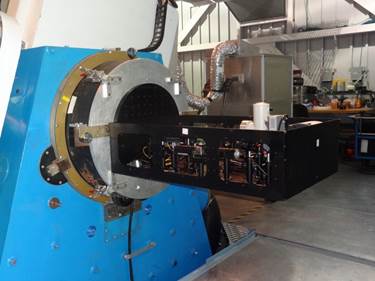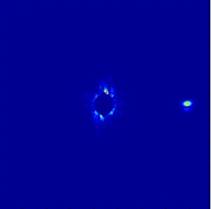

Deqing Ren, California State University Northridge, ren.deqing@csun.edu
On January 13, 2015, a portable adaptive optics (P-AO) was tested with the Apache Point Observatory (APO) 3.5-meter telescope. On a limited observational time of two half-nights, our P-AO successfully demonstrated that a portable adaptive optics is able to deliver diffraction-limited high-resolution imaging in the NIR with the APO 3.5-meter telescope.

Figure 1. P-AO (black open box) installed on APO 3.5-meter telescope Nasmyth port.
Figure 1 shows the P-AO installed on the APO 3.5-m telescope Nasmyth port. The P-AO’s small size is clearly apparent. During our observation, the average seeing parameter varies from 1.2"~1.4", and the wind speed is in the range of 5~13m/s. Here, the observation results of Alp Tau with and without our AO corrections are shown in the following link in a video. It is clear that our P-AO can provide effective wavefront correction and provide close diffraction-limited images.
http://www.csun.edu/~rd436460/APOdocuments/alp_Tau_AO_on_off.avi
One of the P-AO applications is for high-contrast imaging of exoplanets. Figure 2 shows the observation result of the Kap Gem in this run, which was achieved with an exposure of less than one hour. Kap Gem has a magnitude of V = 3.57. As shown in the figure, after our AO correction and dedicated IRS reduction (ApJ 753, 12), the companion can be seen clearly (left panel), with a contrast of 6x10^-5 (right panel), which is close to the results achieved with current 8-meter class telescopes. This initial result demonstrated that equipped with high-performance adaptive optics, a 3~4 meter telescope can be used for many scientific observations that can only be done previously on 8-m class telescopes. As commented by Dr. Patrick Gaulme, an astronomer with the SDSS survey at the APO: "As a scientist, I am fully convinced that an AO on the APO's 3.5-m telescope would be a way to give it a second life".


Figure 2. Reduced Kap Gem with AO correction and IRS reduction (Left), and the associated contrast plot (Right).
California State University Northridge (CSUN) is engaging in the development of high-performance portable adaptive optics (Applied Optics, 53, 14; ApJ, 753, 12; PASP, 124, 12; Opt. Eng. 51, 12; RAA, 12, 12; RAA, 11, 11), from solar to stellar high-resolution imaging. In another test run with the European Southern Observatory (ESO) 3.58-m New Technology Telescope (NTT) in July 2014, our P-AO delivered diffraction-limited performance at NIR H band. The following link shows a video of the Fomalhaut without and with our P-AO correction. As shown in the video, our P-AO is able to deliver extremely-stable AO corrected images.
http://www.csun.edu/~rd436460/Documents/Fomalhaut_H_BAND_EX-AO_NTT.avi
One of the major goals for the construction of a large astronomical telescope is for high-spatial resolution imaging to resolve distant scientific targets in the universe. However, ground-based astronomical observations suffer from the so-called atmosphere turbulence perturbation, which makes a large telescope equivalent to a small telescope of ~ 0.100-meter aperture size only, and which seriously limits these telescopes’ scientific capabilities. To overcome this limitation, an AO system is needed to achieve the telescope’s theoretical high-spatial resolution. For historical reasons, almost all 4-meter class telescopes have no AO, since these telescopes only have a Nasmyth or a Cassegrain focus, where the instrument can be installed and where the physics space is limited. These telescopes are still intensively used for scientific observations. Development of a compact and affordable AO system that can be used with these telescopes and provide best performance will be a breakthrough for the astronomical society as a whole.
Currently, the P-AO uses a deformable mirror (DM) with 97 actuators, and can achieve an open-loop correction speed over 1000 Hz, which is limited by the DM's resonant frequency. By updating to a high-speed DM, the P-AO can achieve an open-loop speed up to 2000Hz. The P-AO is being used for exoplanet high-contrast imaging for a project led by Prof. Yongtian Zhu (NIAOT), and will also be available to any astronomical research group for high-angular resolution imaging.
This work is supported by the National Science Foundation (NSF) early career program under the grant ATM-084144. Our AO, with a small physics size, low cost, high-performance and being quickly duplicable, can be immediately used with current 4-meter class telescopes that still have no AO, and may revolutionize these middle-size telescopes’ science capabilities for high-resolution imaging.